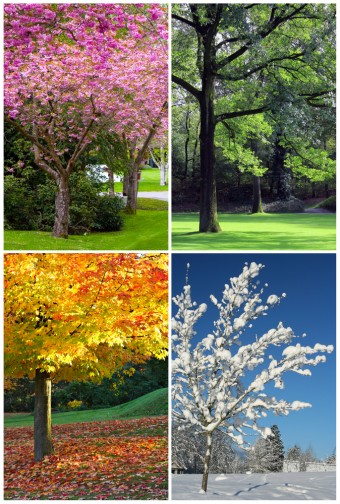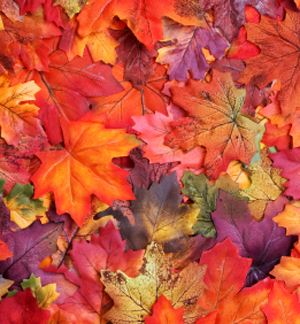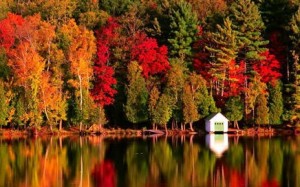Why are the seasons called winter, spring, summer, and fall?
 “Winter” derives from the Proto-Germanic *wentruz, meaning winter. This in turn probably comes from the Proto-Indo-European (PIE) *wed, meaning “wet”. Alternatively, it may come from the PIE *wind-, meaning “white”. Either way, the Proto-Germanic *wentruz gave rise to the Old English “winter” as the fourth season of the year and the name for the season has stuck around ever since.
“Winter” derives from the Proto-Germanic *wentruz, meaning winter. This in turn probably comes from the Proto-Indo-European (PIE) *wed, meaning “wet”. Alternatively, it may come from the PIE *wind-, meaning “white”. Either way, the Proto-Germanic *wentruz gave rise to the Old English “winter” as the fourth season of the year and the name for the season has stuck around ever since.
“Spring”, referring to a season rather than the many other meanings of the word, first popped up in the 16th century. Starting in the 14th century, this time of year was called “springing time” and then in the 15th century this got shortened to “spring-time”, and then further shortened in the 16th century to just “spring”. The 14th century “springing time” came about in reference to plants “springing” from the ground and the like. Before the season was called these things, it was called “Lent” in Old English.
“Summer” came from the Old English name for the season “sumor”, which in turn came from the Proto-Germanic *sumur-, which itself came from the Proto-Indo-European root *sam-, meaning summer. *sam- seems to be a variant of the Proto-Indo-European *sem- meaning “together / one”.
The origin of “fall” as a name for a season, rather than the more common “autumn”, is not perfectly clear, though it’s thought that it probably came from the idea of leaves falling from trees and many plants, particularly the contraction of the English saying “fall of the leaf”. It first popped up as a name for a season in the later 16th century in England and became particularly popular during the 17th century, at which point it made its way over to North America.
Funny enough, calling autumn “fall” in England has since passed out of widespread practice, but has survived as a common name for the season in North America. This is not unlike how “soccer” was originally one of the most popular names for the sport in England around its inception and a long time after, which spread to North America, only to have the name die out in England, leading many to believe “soccer” is an “American” name for the sport, rather than one of the original names for it in England. (For more on this see: The Origin of the Word “Soccer”.)
While you didn’t specifically ask it, you might now be wondering what the origin of “autumn” is. “Autumn” came to English via the Old French “autompne”, meaning autumn. This in turn came from the Latin “autumnus”, also meaning “autumn”. From here things get murky, but it’s thought “autumnus” probably came from an Etruscan word and is possibly related to the Latin “augere” meaning “to increase”. Beyond that, nobody is quite sure why the season was originally called that.
Calling the season “autumn” in English first popped up in the 12th century, though was a rarity until around the 14th century. It then began to pick up steam and became common in the 16th century, about the same time calling it “fall” popped up as the name for the season. Before calling the season “autumn” or “fall” in English, it was called “harvest”.
Incidentally, you may also wonder why the seasons are called “seasons”. The word “season” in this context comes from the Old French “seison”, meaning “sowing / planting”. This in turn came from the Latin “sationem” meaning “sowing”. Initially this referred to actually sowing seeds, but later, as with the Old French “seison”, shifted definition to refer to the time period when you sow seeds, so literally “seed-time”. “Season” in this sense in English popped up around the 13th century. It was also around this time that “season” popped up referring to seasoning food- in this case from the Old French “assaisoner”, meaning “to ripen”.
If you liked this article, you might also like:
- Why Humans Seem to Get Sick More in Winter
- Why the Late Part of the Summer is Known as the Dog Days
- Why Do Leaves Change Color in the Autumn
Bonus Facts:
- “Spring” as in “to leap” comes from the Proto-Germanic *sprenganan from the Proto-Indo-European *sprengh-, meaning “rapid movement”.
- “Spring”, as in a stream, first popped up around the 13th century. Like the “Spring” as in the season, this came from the idea of something “springing up”, in this case water springing from the ground.
[Image via Shutterstock]
Expand for References
- Barnhart Concise Dictionary of Etymology
- Etymology Spring
- Etymology Summer
- Etymology Autumn
- Origin of Autumn
- Etymology Seasons
- Etymology of Winter
- Capitalize Seasons
- Autumn
Why Leaves Change Color in the Fall
The primary thing that triggers the changing of colors in leaves is the length of day. However, moisture and temperature play a role as well. For instance, an extreme drought in the summer can delay somewhat the changing of the colors in fall. Why this is the case is not wholly understood, but it is possibly from the tree not being able to make as much food to store up for the winter, in the case of the drought, so it might be trying to push the envelope a little in terms of making food for a couple more weeks before needing to shed the leaves.
Temperature also plays a part in the ultimate vividness of the color. However, as far as the timing goes, seems to play a very small role given that trees of the same species at very high elevations, where it is colder, will have their leaves change color at nearly the exact same time as those of the same species at lower elevations on the same latitude line.
Primarily though, as the length of day shortens, at a certain point which varies by species, some mechanism in the tree will trigger it to begin the process of closing up the veins to the leaves and eventually shedding them, lest they freeze while the veins are still open which can potentially harm the tree.
There are three main things that give leaves their color. Those are: chlorophyll (green), which is necessary for photosynthesis; carotenoids, such as carotene and xanthophylls, which produce the orange and yellow colors, but whose roles are not entirely understood; and anthocyanins, which give us the shades of red and purple.
In the former two cases of chlorophyll and carotenoids, they are both present in the leaves during the summer, but the chlorophyll more or less covers up the carotenoids, so you see a mostly green leaf, rather than orange or yellow. The anthocyanins, on the other hand, are primarily produced as a result of glucose that is trapped in the leaves when the veins are closed off. These sugars then break down as a result of sunlight and produce the red and purple pigments.
During the summer, the plant is continually producing chlorophyll to aid in the production of glucose, which the tree uses for food. Once the day length decreases sufficiently, the tree gradually starts to decrease the production of chlorophyll and the veins to the leave slowly close off. When this happens, what you have left is the carotenoids and, depending on the species and environmental factors, possibly the produced anthocyanins.
Trees and their colors:
- Oak leaves tend to turn brown or red or a mix of those two.
- Hickory leaves tend to turn bronze colored.
- Aspen leaves tend to turn golden colored.
- Dogwood leaves tend to turn a mix of purple and red.
- Maple tree leaves vary quite a bit in autumn color. Red maple will turn scarlet. Sugar maple will turn orange-ish/red. Black maple will turn bright yellow.
- Elm tree leaves tend to simply fall off without really changing color much before falling.
- While most trees will not leave much of any glucose in the leaves before closing up the veins completley, some do and the formation of anthocyanin pigments from glucose left in tree leaves is somewhat of an oddity in nature. It is not known exactly why these trees would waste the food in the leaves like this (such wastefulness of produced food being rare in nature). Some scientists believe it helps the trees keep the leaves longer as the anthocyanins lower the freezing point of the leaves. Others think it is because the anthocyanins, once absorbed into the ground from the composted fallen leaves, help prevent certain other plant species from growing where the leaves fell. Thus, making sure the tree doesn’t have much competition for nutrients in the soil around the tree.
- Anthocyanin pigments give the colors to such things as: cranberries, red apples, concord grapes, blueberries, huckleberries, cherries, strawberries, and plums, among others.
- Carotenoids give the color to such things as: corn, carrots, daffodils, rutabagas, buttercups, and bananas.
- The eventual brown color of leaves comes from waste left in the leaves when the veins closed up, specifically from tannin. Tannin is a bitter plant compound that either binds or shrinks proteins and other organic compounds, such as amino acids and alkaloids.
- The destruction of tannin plays an important part in the ripening process of foods, as well as the aging of wine.
- The most vivid colors on tree leaves can typically be observed after a succession of very warm sunny days in autumn, which in turn give way to cold, but not freezing, nights. This is a result of the fact that a lot of sugars will be produced in the daytime in these leaves, assuming there is still moisture present, but the veins in the leaves will be closed off, or nearly closed off, so the sugars remain in the leaves. This spurs production of the anthocyanin pigments. If there are also carotenoids present, you’ll see from this some vivid leaves which may contain some mix of yellow/orange/red/purple colors.
- When the tree’s leaves change color varies quite a bit among different species. Certain tree’s leaves will begin changing in late summer, when most other plant’s leaves are still green. On the other end of that, certain trees, like Oaks, won’t have their leaves change until well after most other species of trees have already lost all their leaves.
- Fallen leaves are essential to most forests. A layer of fallen leaves provides a damp, protected environment for certain tree seeds to germinate in. The leaves themselves are also eventually composted into the ground and in turn enrich the soil. Because of the former need for the leaves for proper seed germination in some trees and the ability of the leaves to hold in moisture in the ground, many types of worms can destroy the ability for forests to spread and have new growth as they quickly multiply and process the fallen leaves making for rich soil and a clean forest bed, the latter of which, being a bad thing for most forests.
- Leaves are the food processing factories for trees. The plants use their roots to take in water and other essential nutrients. The leaves then use the water and carbon dioxide from the air, in combination with sunlight, to turn the water and carbon dioxide into glucose, also giving off the byproduct, oxygen. It then uses the glucose for energy for growing and maintaining itself. Excess glucose is then turned into starch by the trees and used during winter for food.
- “Evergreen” trees have needle-like leaves, these needles will typically stay on for two to four years before falling off and making way for new leaves. These special type of leaves are specially made for surviving freezing temperatures without damage, which is why they can stay on year round when their broad-leaved brethren cannot keep their leaves. The primary disadvantage to them over broad leaves is the lessened surface area for creating food.
- Leaves are considered a plant organ and generally consist of: an epidermis that covers the leaf completely; an interior chlorenchyma (plant tissue consisting of parenchyma cells that contain chlorophyll), which is called a mesophyll; and veins that provide the leaves with water and necessary nutrients.











.jpg)
.jpg)


.jpg)





0 comments:
Post a Comment
Note: Only a member of this blog may post a comment.